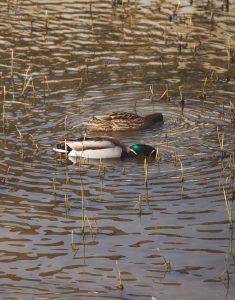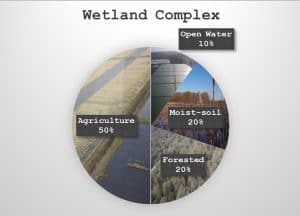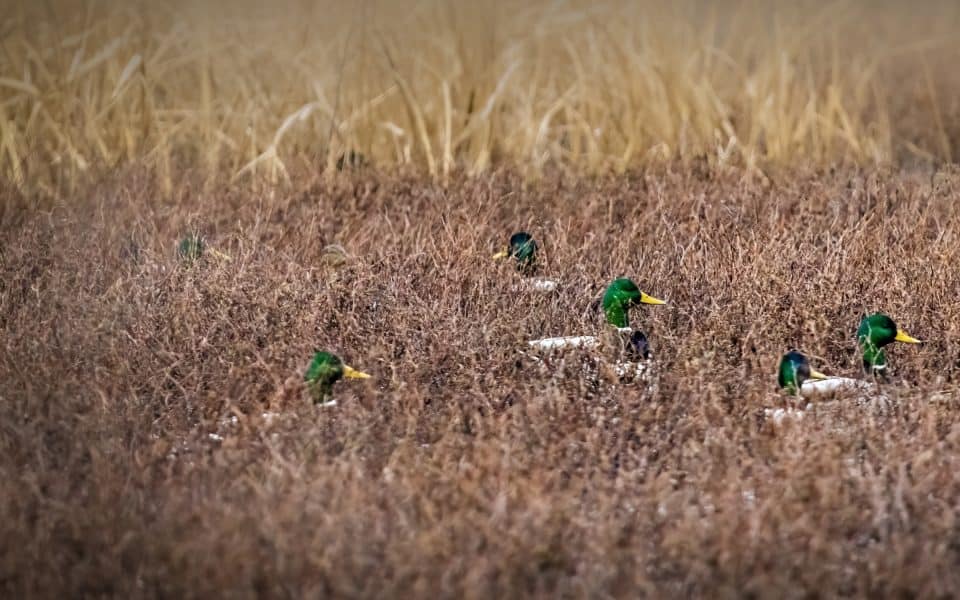When it comes to duck hunting or managing habitat for waterfowl, understanding the biology of your target species can be a game-changer. For duck hunters, knowing how these birds allocate their time and energy during the critical winter months can significantly improve both hunting success and habitat management. As northern temperatures drop and food sources become unavailable, mallards migrate south in search of open wetlands and abundant food. Their winter goals are simple: survive, find a mate, and prepare for the long journey back to their breeding grounds.
Winter isn’t downtime for mallards. It’s a season filled with activities crucial to their survival and future breeding success. For hunters and habitat managers, understanding the factors that drive mallard behavior during winter can put you in the right place at the right time, and help you create better habitats for these highly targeted birds.
Feeding Strategies for Wintering Mallards

Azahara Perez
Upon arrival at their southern wintering grounds, mallards need to replenish the energy reserves lost during migration. Their initial foraging focus tends to be on high-energy foods, such as standing crops or waste grains left behind in agricultural fields (rice, milo, corn) and seeds or tubers found in moist-soil wetlands. These foods are rich in carbohydrates and provide the calories needed to restore fat reserves essential for survival.
However, mallards’ dietary needs shift as winter progresses. While waste grains are essential at times, they alone don’t provide the wide-ranging nutrition necessary for a complete diet. Grain-heavy diets lack critical nutrients, such as protein and other micronutrients, that mallards require. As winter advances, mallards begin incorporating more diverse food sources. To meet their nutritional needs, mallards turn to moist-soil vegetation, which offers seeds and tubers from a wide variety of grasses, sedges, and forbs.
Protein needs also becomes increasingly important later in winter for molting and subsequent egg production. Feathers are made up of 85% protein and aquatic invertebrates are the primary source of this for mallards. Forested wetlands and moist-soil habitats are critical during this time, as they provide more aquatic invertebrates than other wetlands due to the leaf litter or thatch to support them.
In severe winter conditions, mallards are also strategic in their foraging behavior. They’ll focus on energy-dense food sources like grains when temperatures drop, as these foods offer more calories per bite. However, they’ll diversify their diets during milder weather, feeding on a variety of vegetation and invertebrates to maintain balanced nutrition.
How Wintering Mallards Stay Warm in Cold Weather
Beyond the need for food, staying warm is another challenge that mallards face during winter. While wetland habitats offer abundant food resources, certain types of wetlands also provide critical shelter from the elements. Wetlands that feature a forested or shrubby component—such as bottomland hardwood forests or scrub-shrub wetlands—are particularly important during cold snaps. These areas offer vertical cover in the form of trees, shrubs, and dense vegetation, which act as natural windbreaks. Forested wetlands provide a microclimate where temperatures are slightly warmer, and the vertical cover helps trap rising heat, giving mallards a reprieve from the cold winds. These sheltered habitats allow mallards to conserve energy that would otherwise be spent on maintaining body heat. By minimizing the calories expended on thermoregulation, mallards can instead focus on other activities.
Additionally, forested wetlands often contain food resources such as acorns, seeds, and tubers that can be consumed with minimal energy expenditure, as they’re found in shallow, sheltered water. This dual benefit—shelter from cold and easy access to food—makes these wetlands vital for mallards during harsh winter conditions.
Courtship Behavior of Wintering Mallards

James Callicutt
Winter is also the time when mallards begin searching for mates, as pair bonds are usually formed during the mid-to-late winter months. Unlike some bird species that mate for life, mallards are seasonally monogamous, forming new pairs each year. By late January, most mallards have paired off, and this courtship process is an essential part of their winter activities.
Courtship typically begins in more open habitats like moist-soil and agricultural wetlands, where food is abundant and competition for mates is visible. However, when mallards are ready to solidify pair bonds, they often move to more secluded areas, such as forested or scrub-shrub wetlands. These areas offer the isolation and privacy mallards need to form strong pair bonds without interference from other pairs or disturbances.
For hunters, understanding this shift in behavior can greatly improve late season hunting success. During mid to late-winter, mallards are more likely to seek out these sheltered, less-disturbed wetlands for both food and courtship. For habitat managers, maintaining or restoring these types of wetlands is crucial for providing the necessary environment for wintering mallards to form pair bonds and prepare for the breeding season.
Avoiding Predators: Survival Tactics of Wintering Mallards
Staying safe is another critical aspect of survival for wintering mallards. Predators such as birds of prey and coyotes are a threat, and mallards use a variety of strategies to avoid becoming prey. One of the most common strategies is to gather in large groups—a behavior that provides “safety in numbers.” Large groups of ducks are more vigilant and have more eyes to detect potential threats.
This same behavior helps mallards avoid hunters. In areas of high hunting pressure, mallards quickly learn to alter their behavior, avoiding heavily hunted areas in favor of quieter, less-disturbed locations. Mallards will often use lower quality habitat when pressure is greater on quality wetlands. This adaptive behavior means hunters need to be flexible in their approach, paying attention to changes in mallard movement patterns as hunting pressure builds throughout the season. It also underscores the importance of rotating hunting pressure and providing refuge areas where ducks can rest and feed undisturbed.
Habitat Features That Attract Wintering Mallards

James Callicut
Mallards thrive in a landscape that offers a variety of wetland types. Research from Mississippi State University shows that mallards are most abundant in landscapes comprising of flooded cropland (50%), forested wetlands (20%), permanent-open water (10%), and moist-soil wetlands (20%). Rather than staying in one place, mallards move between these habitats to meet their needs for food, shelter, and courtship. Hunters and habitat managers should recognize that mallards are highly mobile during the winter months, often traveling within a 12 to 16-mile radius to find the best resources. For habitat managers, this means that creating or maintaining a mosaic of wetland types is key to keeping mallards in the area. For hunters, it means adapting to mallards’ movements by scouting regularly and being willing to move locations throughout the season.
Not all wetlands are created equal when it comes to providing quality habitat for ducks. Just because you have a mix of flooded agriculture, moist-soil, and forested wetlands doesn’t mean they are offering the right resources. For example, the value of an agricultural wetland depends on factors like crop type and harvest status. A soybean field provides far less nutrition compared to a rice or corn field. Similarly, the quality of moist-soil, forested, or scrub-shrub wetlands can vary widely based on their composition and management. Simply having diverse wetland types doesn’t guarantee duck use—quality is key!
How to Use this Knowledge
Whether you’re a hunter looking to increase your success, or a habitat manager focused on creating better habitat for waterfowl, understanding the life history of wintering mallards is crucial. By tailoring your approach to their feeding habits, courtship behaviors, and landscape preferences, you can significantly improve your outcomes.
The next time you head out for a hunt or plan wetland restoration or management, remember knowing your quarry is half the battle. Understanding mallards’ wintering behaviors and needs will help ensure healthier populations, more successful hunts, and more effective habitat management strategies.
Join our weekly newsletter or subscribe to GameKeepers Magazine.
Your source for information, equipment, know-how, deals and discounts to help you get the most from every hard-earned moment in the field.









